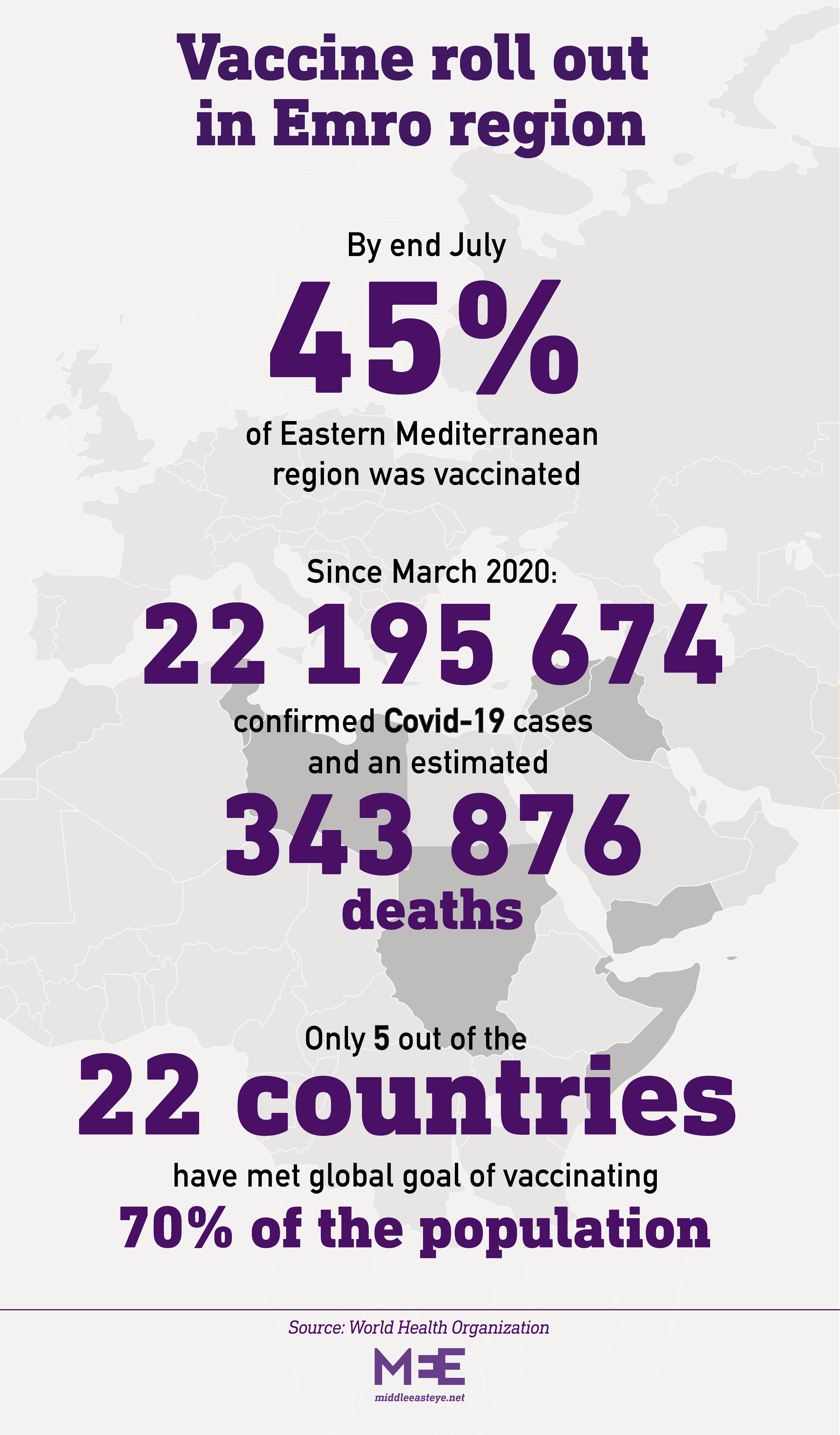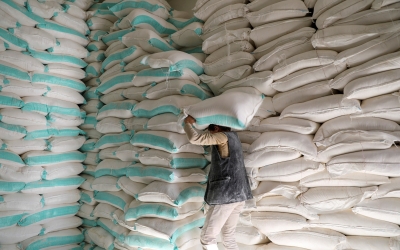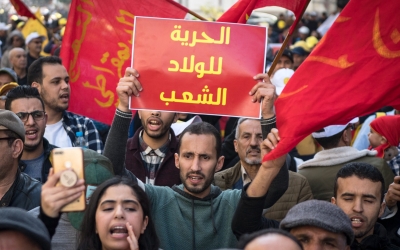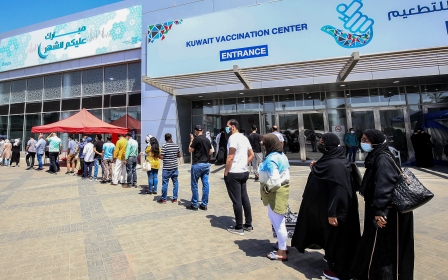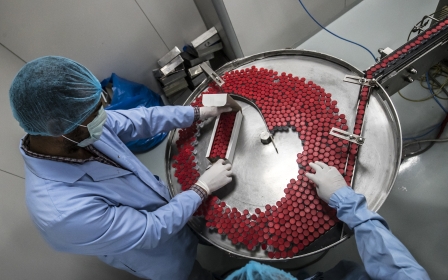How the Covid vaccine rollout exposed inequality in the Middle East

Covid-19 cases are rising yet again, and the uneven distribution of life-saving vaccines could leave poor countries in the Middle East and North Africa even further behind.
In late July, the World Health Organisation (WHO) raised alarm over increasing Covid cases in the Eastern Mediterranean region (EMRO), which spans Morocco to Pakistan but does not include Israel and Algeria.
Given widespread Covid-fatigue and assertions that the new strain may be highly contagious though not necessarily deadly, the story fell into obscurity.
'Armed conflict, political instability, climate shocks and the secondary impacts of the Covid-19 pandemic have weakened capacities to withstand and recover from shocks'
- Robert Mardini, director-general, ICRC
But as health experts have repeatedly warned, the pandemic isn't over.
Covid cases haven't fallen. They come and go in waves. Deaths have decreased, but the virus still has the capacity to overwhelm health systems and kill.
New MEE newsletter: Jerusalem Dispatch
Sign up to get the latest insights and analysis on Israel-Palestine, alongside Turkey Unpacked and other MEE newsletters
The Covid-19 pandemic and the subsequent rush towards universal vaccine coverage didn't illustrate merely the tremendous gap between rich countries and poorer countries but also the immense inequities that exist between countries and regions themselves.
And whereas the African continent remains the most poorly covered region when it comes to vaccines, it is in the Middle East that these inequities have been most intense.
By August 2022, around 62 percent of the world had received vaccines. Whereas the UAE and Qatar have 98 percent and 94 percent vaccination coverage, just 1.5 percent of Yemenis have received the vaccine.
Similarly, coverage in Syria (10 percent), Libya (17 percent) and Palestine (34 percent) are far below the global average. Eight out of the 21 countries in EMRO have yet to reach 20 percent coverage.
The lack of urgency around the story masked another symptom of the pandemic: inequality.
Since the Covid-19 pandemic was declared in March 2020, the response to the virus and subsequent access to a life-saving vaccine have illuminated the vast gulf between rich western nations and much of the developing world.
The shortage of vaccines saw the emergence of the phrase "vaccine apartheid," which highlighted the inequities between the haves and the have-nots.
But as the virus mutated into several new strains, and vaccines became abundantly more available and their efficacy more debatable, the discussion around equity dissipated.
Disparity between countries
At the end of December 2021, the WHO had enlisted eight vaccine products for use around the world. The immediate goal was to prevent fatalities and to protect health systems from becoming overwhelmed.
Over the past year-and-a-half, vaccines were brought into Eastern Mediterranean region through a variety of means.
Higher-income countries in the region, like Qatar and the United Arab Emirates (UAE), directly procured vaccines, while lower-income countries, such as Yemen, relied on the Covax coalition or on donations through friendly countries.
In March 2021, Sudan became the first country in the Middle East and North Africa to receive vaccines through Covax.
Vaccination efforts, however, have been fraught, with several obstacles other than availability. The successful administration of vaccines was also contingent on the state of existing health systems themselves.
In Yemen, where a brutal war has been raging since 2014, factors such as political instability, corruption, a shortage of medical facilities and staff willingness have hampered the vaccination drive.
"First there were no vaccines. Then, when vaccines came, Yemenis were given Johnson & Johnson or AstraZeneca vaccines, seen as having caused health issues in the West," Aisha Jumaan, from the Yemen Foundation, said.
"Yemenis felt they were being given reject vaccines. So this fuelled mistrust and disinformation," Jumaan told MEE.
In March 2021, the WHO said it expected 21 percent of Yemenis to be vaccinated by the end of the year. By early August 2022, less than 2 percent had been vaccinated.
"The main reason for low coverage in Libya and Yemen is conflict, limited access to population and political challenges," a WHO spokesperson told MEE.
"North Yemen's de facto authorities do not allow delivering Covid-19 vaccine to the population living under their control. Southern Yemen is planning to vaccinate at least 30 percent of the population living in the south by December 2022," the spokesperson said.
With about 10 medics for every 10,000 people and around half of Yemen's health facilities damaged from the conflict, it is still unclear if these goals can be met.
Similar difficulties were reported in several other countries across the region.
In Syria, while some vaccines became available for high-risk groups in April 2021, it was only in late 2021 that Covid-19 vaccines became accessible to the public.
In February 2022, the WHO said that just 5 percent of Syrians had received the vaccine. It announced ambitions to vaccinate 40 percent of the population by April. But by August 2022, the needle hadn't moved past the 10 percent mark.
A spokesperson for the WHO in Damascus told MEE that misinformation and vaccine hesitancy were among the reasons for the low coverage in the country.
"There is no current lack of vaccines for Covid-19 in Syria. The vaccine in stock is currently sufficient to vaccinate almost 45.8 percent of the population in whole of Syria," the WHO representative said.
Unreliability of data
The reporting of Covid-19 death tolls around the world has remained notoriously unreliable. Health experts have therefore repeatedly warned that fatalities linked to the virus have been under-reported and likely underestimated.
By the end of 2021, the world death toll was recorded at 5.9 million, but a study by the US-based Institute for Health Metrics and Evaluation (IHME) published in March 2022 argued that the death toll might have been three times the reported number.
The IHME used a tool called "excess mortality," looking at the number of deaths during the period and comparing it to trends over recent years.
It concluded that the number of excess deaths was highest in South Asia, and the Middle East and North Africa, with the number of Covid-19 related deaths in Egypt, Morocco, Sudan and Yemen likely to be more than 10 times higher than reported.
Though it said more research was required to distinguish between "the proportion of excess mortality that was directly caused by SARS-CoV-2 infection and the changes in causes of death as an indirect consequence of the pandemic," the implications were clear: the full impact of the pandemic is yet to fully unravel.
'There were several phases of Covid-19 in Yemen, and in the first phase we lost a lot of people, including many medical professionals'
- Aisha Jumaan, Yemen Foundation
It is in Yemen, again, where the shortages of Covid-19 tests, protective equipment and vaccines and a shortfall of reporting mechanisms provide a snapshot of the extent of under-reporting.
According to official stats, there were just 11,895 cases of Covid-19 in Yemen. Out of these cases, 18 percent, or 2,152, Covid-19 positive Yemenis died from the virus. This is among the highest rate in the world.
"There were several phases of Covid-19 in Yemen, and in the first phase we lost a lot of people, including many medical professionals," Jumaan said. "In a country where there is a shortage of medical professionals, the impact on society was very large."
In late July, the WHO said Covid-related deaths in EMRO had increased by 26 percent.
The world health body described the rising cases in Sudan and associated deaths as having gone "beyond the country's ability to respond".
According to the latest reported statistics, the worldwide number of Covid-related deaths at the beginning of August 2022 was an estimated 6.41 million, with a reported 345,429 deaths in the region between Morocco and Pakistan.
Vaccine anxiety
In July 2021, researchers conducted a cross-sectional study of the Arab world to investigate attitudes towards vaccines.
The study, published in the Saudi Pharmaceutical Journal, said that its survey of four Arab countries found that the Arab world was likely to be a lot more hesitant than the US, Canada or China in accepting the vaccines. It argued that the matter came down to a lack of trust in government and the social and economic context.
'Almost half of the Jordanians and Lebanese citizens were against receiving the vaccine'
- Saudi Pharmaceutical Journal
"Almost half of the Jordanians and Lebanese citizens were against receiving the vaccine. The economic, social, and political instability in Lebanon may have loosened the trust of the public in their government regarding the fair provision of safe and effective vaccines that are held and stored under optimal conditions," the study argued.
Likewise, migrants or refugees without documents and political dissidents have also been reluctant to share personal data, often needed in documenting Covid-19 vaccines, with authorities.
Health experts and economists say the slow rate in vaccination uptake in the Middle East cannot be understood outside the social and economic challenges facing so many communities across the region. Hesitancy has also been reported in Sudan, Lebanon, Iraq and Jordan.
The anxiety over vaccinations is a symptom of structural inequity of people's daily lives.
For example, in the occupied Palestinian territories, be it in Gaza, East Jerusalem or the West Bank, the pandemic did little to stop Israeli forces destroying homes, forcibly displacing families, restricting movement and maintaining a tight grip over medication and equipment.
In July 2022, Physicians for Human Rights said that Israeli authorities rejected a third of medical-permit requests for Palestinian minors in the besieged Gaza Strip to travel to occupied East Jerusalem, the West Bank or Jordan to receive urgent medical in 2021.
'Covid-19 vaccination went down the priority list in comparison to the provision of basic day-to-day life commodities, such as food, medicine and electricity'
- WHO Damascus spokesperson
Between 2008-2021, around 840 Palestinians died as they waited for a permit to leave Gaza to receive treatment.
Likewise, it is estimated that around one in four Yemenis are struggling from mental health issues precipitated by political instability and conflict, food shortages and job losses.
Yemen has just 0.21 psychiatrists per 700,000 of the population and 0.17 psychologists per 100,000, compared with 12.4 psychiatrists and 29.03 psychologists per 100,000 US citizens.
In other words, though vaccines are still regarded as the best way to prevent severe Covid-19, populations in several countries in the Middle East and North Africa are dealing with day-to-day struggles that often place the issue at the bottom of their priorities.
"Covid-19 vaccination went down the priority list in comparison to the provision of basic day-to-day life commodities, such as food, medicine and electricity," the representative with the WHO in Damascus said.
"Moreover, this shift in attitude was further fuelled by the global decrease in adherence to public health and social measures, which put people under the impression that the pandemic is over," the spokesperson said.
Spectre of social unrest
Rising Covid-rates, low vaccine coverage and debilitating economic prospects exacerbated by Russian invasion of Ukraine carry with them the prospect of a protracted health and economic crisis in the Middle East.
Even prior to the pandemic, the Middle East and North Africa region was grappling with low annual growth, a lack of quality jobs, political fragility and conflict. The region was marked by rising social unrest in Sudan, Tunisia and Lebanon until Covid-19 restrictions put an end to those.
The World Bank reported that the drop in living standards and livelihoods in Middle East and North Africa during the pandemic was felt most intensely by the poorest echelons of society. In Egypt and Tunisia, for instance, the bottom 40 percent were hit hardest during the early part of the pandemic.
Academics Adam Hanieh and Rafeef Ziadah warned in late July 2022 that the "pandemic has served to accentuate inequalities across the region, with its effects falling disproportionally on the poor and most marginalised, particularly women, youth, migrants and refugees".
Hanieh and Ziadah, writing in the Journal of Development and Change, argued that "the slow pace of vaccination across most of the region will also place more pressure on government budgets and medical infrastructures in countries that are already least well-equipped to combat the virus".
The duo wrote that the pandemic also led to a deepening of surveillance and authoritarianism in the Middle East and raised the spectre of a new wave of political mobilisations to emerge out of the pandemic.
Likewise, Robert Mardini, the director-general of the International Committee of the Red Cross, said that the MENA region was rapidly headed towards a food security crisis.
"Armed conflict, political instability, climate shocks and the secondary impacts of the Covid-19 pandemic have weakened capacities to withstand and recover from shocks," Mardini said.
"Inflation, combined with the income loss from the pandemic, drove up poverty, especially in rural and already poor households, lowering living standards among the most vulnerable," a spokesperson at the World Bank told MEE.
"Not being vaccinated might have an effect on a household's income (if it makes people stop working), and this, added up with inflation, might hit harder on poverty and inequality," the spokesperson said.
The differences in vaccination rates in the region will ultimately determine the severity of future waves of infection.
Jumaan, from the Yemen Foundation, said this could have been avoided had the richer Arab counties negotiated a price with pharmaceutical companies for the entire region.
Instead, should a new strain or wave emerge, those countries with the least vaccine coverage and the weakest infrastructure will drag their populations back into the cycle of severe sickness, increased fatalities and economic crisis in which they are already locked.
This article is available in French on Middle East Eye French edition.
Middle East Eye delivers independent and unrivalled coverage and analysis of the Middle East, North Africa and beyond. To learn more about republishing this content and the associated fees, please fill out this form. More about MEE can be found here.


